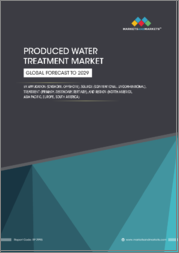
|
시장보고서
상품코드
1346744
생산수 처리 시장 : 현황 분석 및 예측(2023-2030년)Produced Water Treatment Market: Current Analysis and Forecast (2023-2030) |
||||||
이것은 주로 산업 폐기물을 줄이기 위한 정부의 요구와 전 세계 석유 및 가스 소비 증가에 기인합니다. 산업 폐기물에 대한 환경적 관심 증가는 예측 기간 동안 생산수 처리 시장 성장의 촉매제로 작용하고 있습니다. 생산수 처리 세계 시장의 주요 시장 촉진요인은 생산수 처리를 관리하는 엄격한 규칙과 규정입니다. 생산된 물은 비음용 목적으로 사용할 수 있도록 처리해야 합니다. 각국의 석유 및 가스 수요 증가, 다운스트림 활동의 성장, 셰일가스의 경제적 활용은 생산수 처리 시장에 긍정적인 영향을 미칠 것으로 예상됩니다. 원유 가격의 침체와 변동으로 인해 석유와 가스에 대한 투자가 크게 감소하고 있습니다. 이는 수처리 시장에 큰 제약이 되고 있습니다.
석유산업에서 발생하는 폐수 처리에 대한 환경적 관심이 높아짐에 따라, 이러한 추세는 생산수 처리 시장 기업들에게 더 많은 비지니스 기회를 제공하고 있습니다. 폐수처리 솔루션을 제공하는 영국의 SEM은 조류나 색을 유발하는 유기물 등 가벼운 입자가 포함된 원수 처리에 적합한 대체 정화 공정인 DAF(용존공기부상) 기술을 개발했습니다. 이 기술은 도입 후 큰 인기를 끌었습니다. 용존 공기 부양법은 진흙을 농축하는 공정으로 잘 알려져 있으며, 제품 물에서 기름과 지방을 제거하는 데 사용할 수 있습니다. 침전보다 낮은 폐수 탁도를 달성할 수 있기 때문에 점점 더 많은 기업이 DAF를 채택하고 있습니다.
시장 세분화는 위치별로 육상 및 해상으로 구분됩니다. 해양 부문은 생산수 처리 시장에서 대부분의 점유율을 차지하고 있으며, 예측 기간 동안 상당한 성장률을 보일 것으로 예상됩니다. 미국에서는 해양 석유 탐사 및 채굴 활동이 활발하게 이루어지고 있습니다. 미국에는 개조, 현대화 및 업그레이드가 필요한 오래된 유정이 많이 있습니다. 전 세계 해양 석유 활동의 증가는 예측 기간 동안 생산수 처리 시장에 긍정적인 영향을 미치고 있습니다.
기술에 따라 생산수 처리 시장은 물리적 처리, 생물학적 처리, 멤브레인 처리, 화학적 처리 및 기타 처리 부문으로 분류됩니다. 물리적 처리 부문은 생산수 처리 시장에서 가장 큰 시장 점유율을 차지하고 있으며, 멤브레인 처리 부문은 예측 기간 동안 가장 빠른 성장을 보일 것으로 예상됩니다. 멤브레인 처리 부문은 기업들이 멤브레인 바이오리액터를 사용하여 생산수에서 모든 석유계 탄화수소를 효과적으로 제거하여 폐수 품질이 크게 개선됨에 따라 증가하고 있습니다.
생산수 처리 시장 도입에 대한 이해를 돕기 위해 시장은 북미(미국, 캐나다, 기타 북미 지역), 유럽(독일, 이탈리아, 영국, 네덜란드, 프랑스, 기타 유럽 지역), 아시아태평양(중국, 일본, 호주, 한국, 기타 아시아태평양) 및 기타 지역으로 분석됩니다. 의 세계 입지를 기반으로 분석됩니다. 북미는 생산수 처리 시장에서 가장 높은 시장 점유율을 기록하고 예측 기간 동안 상당한 CAGR을 기록할 것으로 예상됩니다. 이는 주로 미국과 캐나다에서 진행되고 있는 석유 및 가스 프로젝트의 확장 및 업그레이드에 기인합니다. 또한, 각국의 석유 및 가스 분야에 대한 유리한 정부 정책, 규제 및 정책, 투자가 시장을 주도하고 있습니다. 예를 들어, 2023년 2월 10일 미국 에너지부 화석에너지 및 탄소관리국은 석유 및 천연가스 개발 및 생산에 따른 생산수(폐수) 특성화, 처리 및 관리에 초점을 맞춘 연구 개발 프로젝트에 1,800만 달러 이상의 자금을 지원한다고 발표했습니다.
이 시장에 진출한 주요 기업들은 다음과 같다:Siemens AG, Aker Solutions, Alderly Plc, Schlumberger Limited, CETCO Energy Services, Veolia Water Technologies, Aquatech International L.L.C, Evoqua Water Technologies LLC, Dow Water & Process Solutions, Xylem Inc.
목차
제1장 시장 서론
- 시장 정의
- 주요 목표
- 이해관계자
- 제한사항
제2장 조사 방법 또는 가정
- 조사 과정
- 조사 방법
- 응답자 프로파일
제3장 시장 주요 인사이트
제4장 주요 요약
제5장 세계의 생산수 처리 시장 신종 코로나바이러스 감염증(COVID-19)의 영향
제6장 세계의 생산수 처리 시장 매출, 2020-2030년
제7장 장소별 시장 인사이트
- 온쇼어
- 오프쇼어
제8장 기술별 시장 인사이트
- 물리치료
- 생물학적 처리
- 막처리
- 화학처리
- 기타
제9장 지역별 시장 인사이트
- 북미의 생산수 처리 시장
- 미국
- 캐나다
- 기타 북미
- 유럽의 생산수 처리 시장
- 독일
- 이탈리아
- 영국
- 프랑스
- 스페인
- 기타 유럽
- 아시아태평양의 생산수 처리 시장
- 중국
- 일본
- 호주
- 인도
- 기타 APAC
- 기타 지역의 생산수 처리 시장
제10장 생산수 처리 시장 역학
- 시장 성장 촉진요인
- 시장 과제
- 영향 분석
제11장 생산수 처리 시장 기회
제12장 생산수 처리 시장 동향
제13장 수요측과 공급측 분석
- 수요측 분석
- 공급측 분석
제14장 밸류체인 분석
제15장 경쟁 시나리오
- 경쟁 상황
- Porter's Five Forces 분석
- 기업 순위 분석
제16장 기업 개요
- Siemens AG
- Aker Solutions
- Alderly Plc
- Schlumberger Limited
- CETCO Energy Services
- Veolia Water Technologies
- Aquatech International L.L.C
- Evoqua Water Technologies LLC
- Dow Water & Process Solutions
- Xylem Inc.
제17장 면책사항
ksm 23.10.17Produced water is a term used in the petroleum industry to describe water produced as a by-product of oil and gas production or used as a heat recovery medium. Produced water is a type of brackish and saltwater brought to the surface from subterranean formations. Oil and gas reservoirs often contain both water and hydrocarbons, either in zones below the hydrocarbons or in the same zones as the oil and gas. Treatment requirements vary around the world. In the United States, these standards are issued by the U.S. Environmental Protection Agency for underground injection and discharges to surface waters. Gravity separators, plate coalescers, hydrocyclones, nutshell filters, and dissolved gas flotation are some of the technologies used in treating wastes from produced water.
It is mainly owing to the government requirements to reduce industrial waste and increasing consumption of Oil & Gas globally. Increasing environmental concerns regarding industrial waste is acting as a catalyst for the growth of the produced water treatment market during the projected period. The major market driver of the global produced water treatment market is the strict rules and regulations governing produced water treatment. The water produced must be treated so that it can be used for non-potable purposes. Rising demand for oil and gas in different countries, growth in downstream activities, and economic utilization of shale gas are expected to have a positive impact on the produced water treatment market. Low and volatile oil prices have significantly reduced oil and gas investment. This is a significant constraint for the water treatment market.
As environmental concerns regarding the treatment of wastewater generated from the petroleum industry grow, such trends are leading to increased opportunities for companies in the produced water treatment market. SEM, a UK company providing wastewater treatment solutions, has developed DAF (Dissolved Air Flotation) technology, an alternative clarification process ideal for treating raw water containing light particles such as algae and color-causing organics. It gained popularity after its introduction. Dissolved air flotation is a well-known mud-thickening process that can be used to remove oil and grease from product water. More and more companies are turning to DAF because it helps to achieve low effluent turbidity than settling.
Based on Location, The Produced Water Treatment market is divided into Onshore, and Offshore segments. The Offshore segment acquired a majority share in the Produced Water Treatment market and is expected to showcase a substantial growth rate during the forecast period. Offshore oil exploration and extraction activities are rising in the USA. The USA has numerous old oil wells that need refurbishment, modernization, and upgradation. The increasing offshore oil activities in the world are positively affecting the produced water treatment market during the forecast period.
Based on Technology, the Produced Water Treatment market is segmented into Physical, Biological, Membrane, Chemical, and other treatment segments. The Physical Treatment segment captured the biggest market share in the Produced Water Treatment market and the Membrane Treatment segment is expected to showcase the fastest growth during the forecast period. The membrane Treatment segment is increasing as companies are using membrane bioreactors to effectively remove the total petroleum hydrocarbons from produced water, resulting in a significant improvement in effluent quality.
For a better understanding of the market adoption of Produced Water Treatment, the market is analyzed based on its worldwide presence in the countries such as North America (U.S.A, Canada, and the Rest of North America), Europe (Germany, Italy, United Kingdom, Netherlands, France, and Rest of Europe), Asia-Pacific (China, Japan, Australia, South Korea, and Rest of Asia-Pacific) and Rest of World. North America registered the highest market share in the Produced Water Treatment market and is expected to register a substantial CAGR in the forecasted period. It is mainly owing to the expansion and upgradation of oil & gas projects taking place in the USA and Canada. Moreover, favorable government policies, regulations, and investments in the oil and gas sector set by various countries are driving the market. For Instance, On February 10, 2023, the U.S. Department of Energy's Office of Fossil Energy and Carbon Management announced more than $18 million in funding for research and development projects that focus on the characterization, treatment, and management of produced water, or wastewater associated with oil & natural gas development and production.
Some of the major players operating in the market are: Siemens AG, Aker Solutions, Alderly Plc, Schlumberger Limited, CETCO Energy Services, Veolia Water Technologies, Aquatech International L.L.C, Evoqua Water Technologies LLC, Dow Water & Process Solutions, and Xylem Inc.
TABLE OF CONTENTS
1 MARKET INTRODUCTION
- 1.1. Market Definitions
- 1.2. Main Objective
- 1.3. Stakeholders
- 1.4. Limitation
2 RESEARCH METHODOLOGY OR ASSUMPTION
- 2.1. Research Process of the Produced Water Treatment Market
- 2.2. Research Methodology of the Produced Water Treatment Market
- 2.3. Respondent Profile
3 MARKET KEY INSIGHTS
4 EXECUTIVE SUMMARY
5 GLOBAL PRODUCED WATER TREATMENT MARKET COVID-19 IMPACT
6 GLOBAL PRODUCED WATER TREATMENT MARKET REVENUE, 2020-2030F
7 MARKET INSIGHTS BY LOCATION
- 7.1. Onshore
- 7.2. Offshore
8 MARKET INSIGHTS BY TECHOLOGY
- 8.1. Physical Treatment
- 8.2. Biological Treatment
- 8.3. Membrane Treatment
- 8.4. Chemical Treatment
- 8.5. Others
9 MARKET INSIGHTS BY REGION
- 9.1. North America Produced Water Treatment Market
- 9.1.1. U.S.A
- 9.1.2. Canada
- 9.1.3. Rest of North America
- 9.2. Europe Produced Water Treatment Market
- 9.2.1. Germany
- 9.2.2. Italy
- 9.2.3. United Kingdom
- 9.2.4. France
- 9.2.5. Spain
- 9.2.6. Rest of Europe
- 9.3. Asia-Pacific Produced Water Treatment Market
- 9.3.1. China
- 9.3.2. Japan
- 9.3.3. Australia
- 9.3.4. India
- 9.3.5. Rest of APAC
- 9.4. Rest of the World Produced Water Treatment Market
10 PRODUCED WATER TREATMENT MARKET DYNAMICS
- 10.1. Market Drivers
- 10.2. Market Challenges
- 10.3. Impact Analysis
11 PRODUCED WATER TREATMENT MARKET OPPORTUNITIES
12 PRODUCED WATER TREATMENT MARKET TRENDS
13 DEMAND AND SUPPLY-SIDE ANALYSIS
- 13.1. Demand Side Analysis
- 13.2. Supply Side Analysis
14 VALUE CHAIN ANALYSIS
15 COMPETITIVE SCENARIO
- 15.1. Competitive Landscape
- 15.1.1. Porters Fiver Forces Analysis
- 15.1.2. Company Ranking Analysis
16 COMPANY PROFILED
- 16.1. Siemens AG
- 16.2. Aker Solutions
- 16.3. Alderly Plc
- 16.4. Schlumberger Limited
- 16.5. CETCO Energy Services
- 16.6. Veolia Water Technologies
- 16.7. Aquatech International L.L.C
- 16.8. Evoqua Water Technologies LLC
- 16.9. Dow Water & Process Solutions
- 16.10. Xylem Inc.











